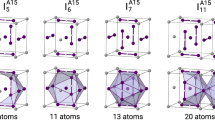Abstract
The orthopyroxene crystal structure can be viewed as the stacking of alternating tetrahedral and octahedral layers parallel to the (100) plane. Easy glide occurs in the (100) plane at the level of the octahedral layer to prevent breakage of the strong Si-O bonds. Dislocations with c and b Burgers vectors have been activated in (100) by room temperature indentation in an orthoenstatite gem quality single crystal. Investigations in transmission electron microscopy show that the b dislocations (b≃9 Å) are not dissociated while the c's (c=5.24 Å) are dissociated into four partials. This result is interpreted by considering the oxygen sublattice as a distorted FCC one. The four c partials are thus Shockley partials bounding three stacking faults. For the two outer ones, synchroshear of the cations is necessary to keep unchanged their sixfold coordination; the oxygen sublattice is locally transformed into a HCP lattice. This accounts for the observed low splitting (≃100 Å) of these faults as compared to the median one (≃500 Å) which does not affect the oxygen sublattice and does not require cation synchroshear.
In a Fe rich orthopyroxene (eulite), semi coherent exsolution lamellae have been studied. Either only c edge dislocations or both b and c edge dislocations occur in the phase boundaries depending upon the thickness of the lamellae. Only the c dislocations are dissociated. From the observed spacing between these mismatch dislocations a crude estimate of the exsolution temperature is proposed T ex ≃ 700° C.
Similar content being viewed by others
References
Amelinckx S (1982) Dislocations in particular structures. In: Nabarro FRN (ed) Dislocations in solids 2. North Holland, Amsterdam p 67
Boland JN (1974) Lamellar structures in low calcium orthopyroxenes. Contrib Mineral Petrol 47:215–222
Buseck P, Nord GL, Veblen DR (1980) Subsolidus phenomena in pyroxenes. In: Ribbe PH (ed) Reviews in mineralogy 7: Pyroxenes Mineral Soc Am, Washington DC, pp 117–212
Cameron M, Sueno S, Prewitt CT, Papike JJ (1973) High temperature crystal chemistry of acmite, diopside, hedenbergite, jadeite, spodumene and ureyite. Am Mineral 58:594–618
Cameron M, Papike JJ (1980) Crystal Chemistry of silicate pyroxenes. In: Ribbe PH (ed) Reviews in mineralogy 7: Pyroxenes. Mineral Soc Am, Washington DC, pp 5–92
Cameron M, Papike JJ (1981) Structural and chemical variations in pyroxenes. Am Mineral 66:1–50
Champness PE, Lorimer GW (1976) Exsolution in silicates. In: Wenk HR (ed) Electron microscopy in mineralogy, Springer, Berlin Heidelberg New York, pp 174–204
Coe RS, Muller WF (1973) Crystallographic orientation of clinoenstatite produced by deformation of orthoenstatite. Science 180:64–66
Coe RS, Kirby SH (1975) The orthoenstatite to clinoenstatite transformation by shearing and reversion by annealing: mechanisms and potential applications. Contrib Mineral Petrol 52:29–55
Deer WA, Howie RA, Zussman J (1978) Rock forming minerals 2A: Single chain silicates. Wiley, New York
Doukhan N (1979) TEM investigation of room temperature microplasticity in Mg Al2O4 spinel. J Phys 40:L 603-L 606
Gilman JJ (1973) Hardness, a strength microprobe. In: Westbrook JK, Conrad H (eds) The science of hardness testing and its research applications. Am Soc Metals, Metals Park Ohio, pp 51–74
Green HW, Radcliffe SV (1972) Deformation processes in the upper mantle. In: Heard HC, Borg LY, Carter NL, Raleigh CB (eds) Flow and fracture of rocks. Am Geophys Union, Washington DC, pp 139–156
Hockey BJ (1973) Use of the hardness test in the study of the plastic deformation of single crystals. In: Westbrook JK, Conrad H (eds) The science of hardness testing and its research applications. Am Soc Metals, Metals Park Ohio, pp 21–50
Hornstra J (1960) Dislocations, stacking faults and twins in the spinel structure. J Phys Chem Solids 15:311–323
Kirby SH (1976) The role of crystal defects in the shear induced transformation of orthoenstatite to clinoenstatite. In: Wenk HR (ed) Electron microscopy in mineralogy. Springer, Berlin Heidelberg New York, pp 465–472
Kirby SH, Etheridge MA (1981) Exsolution of Ca pyroxene from orthopyroxene aided by deformation. Phys Chem Minerals 7:105–109
Kohlstedt DL, Vandersande JB (1973) Transmission electron microscopy investigation of the defect microstructure of four natural orthopyroxenes. Contrib Mineral Petro 42:169–180
Kronberg ML (1957) Plastic deformation of single crystals of sapphire, basal slip and twinning. Acta Metall 5:507–524
Lally JS, Fisher RM, Christie JM, Griggs DT, Nord NL, Radcliffe SV (1972) Electron petrography of Apollo 14 and 15 rocks. Proc Lunar Sci Conf 3rd:401–422
Lefebvre A (1982) Transmission electron microscopy of andalusite single crystals idented at room temperature. Bull Mineral 105:347–350
McLaren AC, Etheridge MA (1976) A transmission electron microscopy study of naturally deformed orthopyroxene. I Slip mechanisms. Contrib Mineral Petrol 57:163–177
Papike JJ, Prewitt CT, Sueno S, Cameron M (1973) Pyroxenes; comparisons of real and ideal structure topologies. Z Kristallogr 138:252–273
Raleigh CB (1965) Glide mechanisms in experimentally deformed minerals. Science 150:739–541
Raleigh CB, Kirby SH, Carter NL, Ave-Lallemand HG (1971) Slip and the clinoenstatite transformation as competing rate processes in enstatite. J Geophys Res 76/17:4011–4022
Smith JV, Stephenson DA, Howie RA, Hey MH (1969) Relations between cell dimensions, chemical composition and site preference of orthopyroxene. Mineral Mag 37:90–114
Sueno S, Cameron M, Prewitt CT (1976) Orthoferrosilite: high temperature crystal chemistry. Am Mineral 61:38–53
Trepied L, Doukhan JC (1982) Transmission electron microscopy study of quartz single crystals deformed at room temperature and atmospheric pressure by indentation. J Phys 43:L77-L81
Turner FJ, Heard HC, Griggs DT (1960) Experimental deformation of enstatite and accompanying inversion to clinoenstatite. Rpt 21st Int Geol Congr Copenhagen 18:399–408
Van Duysen JC, Doukhan JC (1983) Room temperature microplasticity of α spodumene Li Al Si2 O6. Phys Chem Minerals 10:125–132
Veyssiere P, Rabier J, Garem H, Grilhe J (1978) Influence of temperature on dissociation of dislocations and plastic deformation in spinel oxides. Philos Mag 38:61–79
Author information
Authors and Affiliations
Additional information
Associated to CNRS no 234
Rights and permissions
About this article
Cite this article
Van Duysen, J.C., Doukhan, N. & Doukhan, J.C. Transmission electron microscope study of dislocations in orthopyroxene (Mg, Fe)2Si2O6 . Phys Chem Minerals 12, 39–44 (1985). https://doi.org/10.1007/BF00348745
Received:
Issue Date:
DOI: https://doi.org/10.1007/BF00348745




